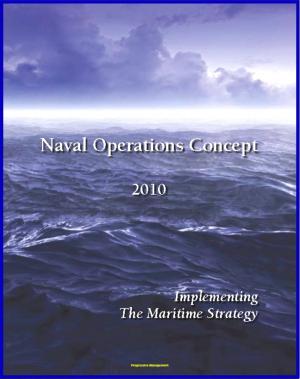Naval Mines in the 21st Century: Can NATO Navies Meet the Challenge? Sea Mines, Danger to Shipping, Sea Lines of Communication (SLOCS), Mine Warfare and Countermeasures (MCM), New Technology Mines
Nonfiction, History, Military, Weapons, Naval| Author: | Progressive Management | ISBN: | 9781311661111 |
| Publisher: | Progressive Management | Publication: | May 28, 2016 |
| Imprint: | Smashwords Edition | Language: | English |
| Author: | Progressive Management |
| ISBN: | 9781311661111 |
| Publisher: | Progressive Management |
| Publication: | May 28, 2016 |
| Imprint: | Smashwords Edition |
| Language: | English |
Professionally converted for accurate flowing-text e-book format reproduction, this unique book examines the current challenge of defending against sea and naval mines.
With the end of the Cold War, NATO countries have embarked on transformation initiatives within their militaries to address the new security realities of the 21st century. One of the realities that has not changed is the threat posed by sea mines. Global proliferation of sea mines, both older variants and advanced new designs, has continued to grow and presents a unique challenge to maritime security. NATO naval forces must be prepared to counter the danger posed by mines to shipping, both civilian and military, and to ensure that vital sea lines of communication (SLOCS), strategic chokepoints throughout the world, commercial ports and naval bases remain open and uncontested as they find themselves participating in more security operations at home and abroad.
There are two main questions that this paper seeks to address. The first concerns the threat. With major advances in military technology and changes to doctrine, is there really a sea mine threat that could pose a significant challenge to today's navies? NATO naval forces are the most sophisticated and technologically advanced in the world. Yet the first Gulf War in 1991 taught us that even relatively inexpensive and unsophisticated sea mines can have catastrophic effects on our capital ships. The low cost, ease of use, and tactical effectiveness of sea mines make them a very potent threat, even to modern navies. Thus, to adequately answer the question of threat, I will consider the problem of proliferation, mine technologies and employment, and methods to counter the threat.
This leads to the second major question. Are NATO members adequately developing their MCM capability to meet the threat of sea mines? While it is true that NATO MCM forces are among the best, there are some notable shortfalls in capability development even as these countries push to develop new systems. This paper will analyze the new programs and initiatives that are shaping NATO's mine warfare community and discuss whether, and how, these programs are addressing the threat. This thesis argues that in an era where expeditionary warfare (and thus command of the littorals) is the central strategic requirement for naval forces, mine warfare must remain a primary warfare discipline and must continue to be properly resourced and developed to face the mine challenge of the 21st century.
CHAPTER I - INTRODUCTION * A. PURPOSE * B. BACKGROUND * C. METHODOLOGY AND RESEARCH LITERATURE * D. ORGANIZATION OF THESIS * 1. Introduction. * 2. The Threat * 3. NATO MIW Capabilities * 4. Case Studies * 5. Conclusion * CHAPTER II - THE THREAT * A. INTRODUCTION * B. MINE TYPES AND EMPLOYMENT * C. METHODS OF ACTUATION * D. MINING TACTICS AND COUNTERMEASURES * E. GEOSTRATEGIC IMPLICATIONS OF PROLIFERATION FOR NATO * CHAPTER III - NATO MCM CAPABILITIES * A. INTRODUCTION. * B. MINE WARFARE ORGANIZATIONS * C. DEDICATED MCM ASSETS * D. ORGANIC MCM * E. CONCLUSION * CHAPTER IV - CASE STUDIES * A. NATO/COALITION NEAR-AREA MCM OPERATIONS * 1. Red Sea/Suez Mining Incident of 1984 * 2. Operation Allied Harvest * B. NATO/COALITION OUT OF AREA MCM OPERATIONS * 1. Operation Earnest Will * 2. Operation Desert Storm * 3. Operation Iraqi Freedom. * C. CONCLUSION * CHAPTER V - CONCLUSION * BIBLIOGRAPHY
Professionally converted for accurate flowing-text e-book format reproduction, this unique book examines the current challenge of defending against sea and naval mines.
With the end of the Cold War, NATO countries have embarked on transformation initiatives within their militaries to address the new security realities of the 21st century. One of the realities that has not changed is the threat posed by sea mines. Global proliferation of sea mines, both older variants and advanced new designs, has continued to grow and presents a unique challenge to maritime security. NATO naval forces must be prepared to counter the danger posed by mines to shipping, both civilian and military, and to ensure that vital sea lines of communication (SLOCS), strategic chokepoints throughout the world, commercial ports and naval bases remain open and uncontested as they find themselves participating in more security operations at home and abroad.
There are two main questions that this paper seeks to address. The first concerns the threat. With major advances in military technology and changes to doctrine, is there really a sea mine threat that could pose a significant challenge to today's navies? NATO naval forces are the most sophisticated and technologically advanced in the world. Yet the first Gulf War in 1991 taught us that even relatively inexpensive and unsophisticated sea mines can have catastrophic effects on our capital ships. The low cost, ease of use, and tactical effectiveness of sea mines make them a very potent threat, even to modern navies. Thus, to adequately answer the question of threat, I will consider the problem of proliferation, mine technologies and employment, and methods to counter the threat.
This leads to the second major question. Are NATO members adequately developing their MCM capability to meet the threat of sea mines? While it is true that NATO MCM forces are among the best, there are some notable shortfalls in capability development even as these countries push to develop new systems. This paper will analyze the new programs and initiatives that are shaping NATO's mine warfare community and discuss whether, and how, these programs are addressing the threat. This thesis argues that in an era where expeditionary warfare (and thus command of the littorals) is the central strategic requirement for naval forces, mine warfare must remain a primary warfare discipline and must continue to be properly resourced and developed to face the mine challenge of the 21st century.
CHAPTER I - INTRODUCTION * A. PURPOSE * B. BACKGROUND * C. METHODOLOGY AND RESEARCH LITERATURE * D. ORGANIZATION OF THESIS * 1. Introduction. * 2. The Threat * 3. NATO MIW Capabilities * 4. Case Studies * 5. Conclusion * CHAPTER II - THE THREAT * A. INTRODUCTION * B. MINE TYPES AND EMPLOYMENT * C. METHODS OF ACTUATION * D. MINING TACTICS AND COUNTERMEASURES * E. GEOSTRATEGIC IMPLICATIONS OF PROLIFERATION FOR NATO * CHAPTER III - NATO MCM CAPABILITIES * A. INTRODUCTION. * B. MINE WARFARE ORGANIZATIONS * C. DEDICATED MCM ASSETS * D. ORGANIC MCM * E. CONCLUSION * CHAPTER IV - CASE STUDIES * A. NATO/COALITION NEAR-AREA MCM OPERATIONS * 1. Red Sea/Suez Mining Incident of 1984 * 2. Operation Allied Harvest * B. NATO/COALITION OUT OF AREA MCM OPERATIONS * 1. Operation Earnest Will * 2. Operation Desert Storm * 3. Operation Iraqi Freedom. * C. CONCLUSION * CHAPTER V - CONCLUSION * BIBLIOGRAPHY















